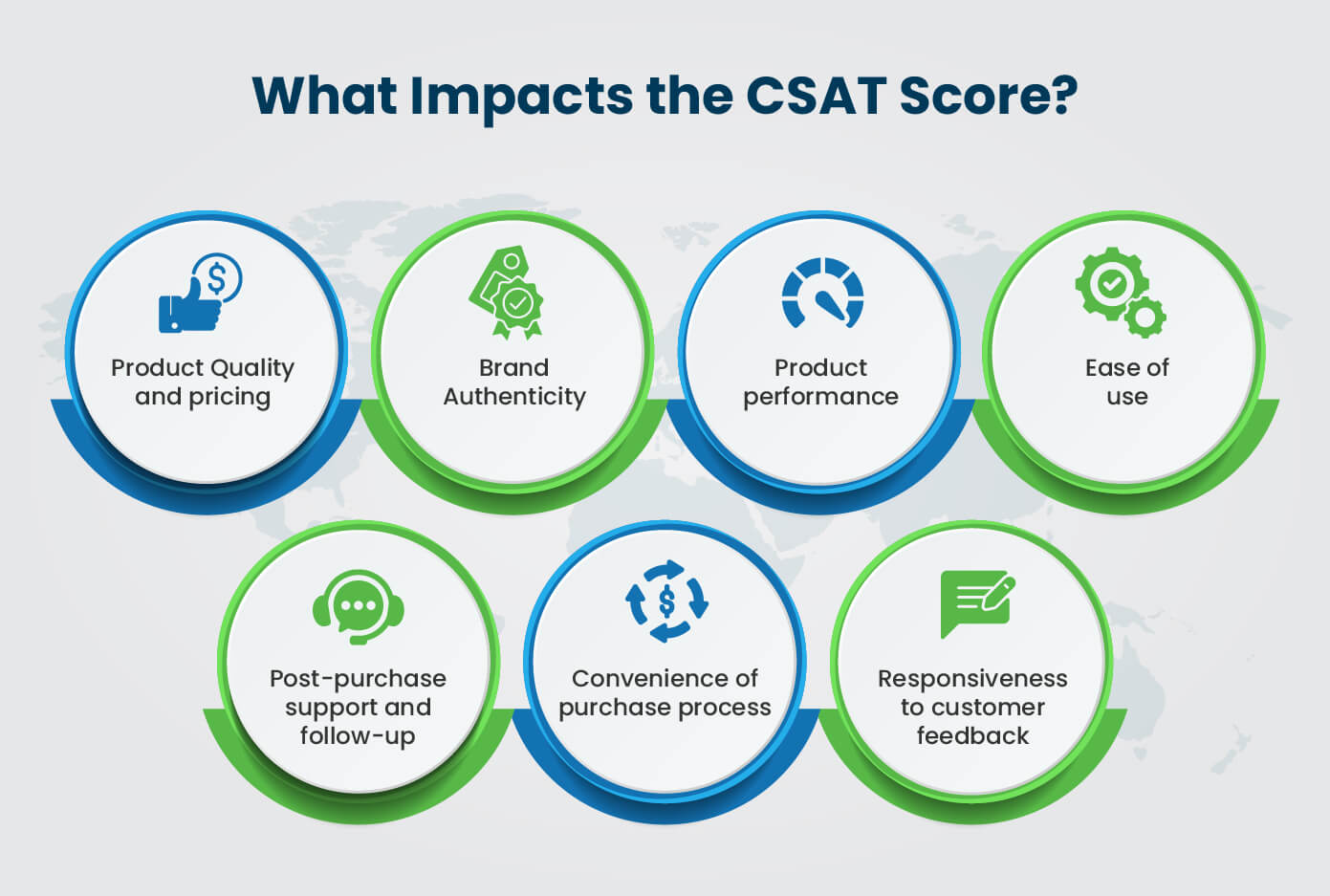Almost any business would agree in a heartbeat that customers are the key to achieving success. But how many of them would say they have a methodology in place to check if their customers are happy? Not many. Everybody knows they should be measuring Customer Satisfaction Score (CSAT) but most businesses don’t know where to start.
This blog aims to be your guide to understanding a key contact center metric, Customer Satisfaction (CSAT), its importance for your business, how to measure it, and not to forget, how to improve upon your existing score.
What is the CSAT (Customer Satisfaction Score)?
Customer satisfaction Score is an indicator of how happy or satisfied your customers are with your products, services, or interactions. It can be a qualitative as well as quantitative score – depending upon the methodology you deploy to measure it.
It serves as a barometer of customer sentiment, offering valuable insights into the efficacy of business operations and customer service efforts. CSAT scores can be derived from various sources, including surveys, feedback forms, and reviews, providing businesses with actionable data to improve customer experiences and foster loyalty.
How to Measure Customer Satisfaction Score: CSAT Survey
There is no one unified methodology to measure the Customer Satisfaction (CSAT) KPI because it largely depends on the type of CSAT questions asked.
To measure the Customer Satisfaction Score, the CSAT survey is one of the most efficient methods. The score is measured by a question at the end of a customer feedback survey, such as:
“On a scale of 1-10 how happy are you with our services?” or “Did we meet your expectations today?” requiring a Yes/No answer.
Or
How satisfied are you with our services?
- Highly Unsatisfied 😪
- Unsatisfied 😒
- Neutral 😊
- Satisfied 😌
- Highly satisfied 🤗
The answer can be a binary yes/no or a numeric number on a scale of 1-10, depending on the business’s preference. The results of such surveys can be averaged to arrive at the Customer Satisfaction Score.
| 💡Also Read | 10 Great Insights from Contact Center Survey for Better Customer Satisfaction |
How to Calculate Customer Satisfaction Score?
The formula to calculate the Customer Satisfaction Score is to assess the total number of satisfied customers, say satisfied and highly satisfied in proportion to the total number of responders on the survey.

In case your business is relying on a scale to measure customer satisfaction (such as 0-5 or 1-10), then the CSAT score can be calculated by:

What is a Good Customer Satisfaction Score (CSAT) – Analyzing Industrial Benchmarks
As mentioned above, there is no one defined method to measure Customer Satisfaction Score (CSAT), similarly, there is no one standard threshold for a good CSAT Score. Going by the general trend, businesses should try to get the number of satisfied customers as close to 100% as possible. Further, it can be a useful practice to benchmark your scores against other competitors in your industry.
The CSAT Score can also vary according to the industrial benchmark and the metrics used.
An example of this can be whether your agents ask your customers to rate them after every call or if there is a system of quarterly feedback.
For most businesses, one helpful rule is to keep the CSAT score at least above 75%, which ensures that 3 out of 4 customers remain satisfied.
Are Net Promoter Score (NPS) and Customer Satisfaction Score (CSAT) different?
Net Promoter Score and Customer Satisfaction Score are two terms that might seem confusing to most people – since they both are satisfaction metrics. But they are inherently different.
CSAT Score measures the satisfaction of your customers concerning a product or a service, whereas NPS is about the loyalty that customers show towards your brand. The question an NPS survey would ask its customers is “How likely are you to recommend our brand to others?”
Factors Impacting Customer Satisfaction Score
What is it that becomes the deciding factor for customer satisfaction? Inevitably competent customer service plays a huge role in ensuring customer satisfaction but there are other factors too. Let’s take a look at some of these:

| 💡Also Read | Overcoming the Top 5 Barriers to Customer-centricity |
How to Boost the Customer Satisfaction Score (CSAT)?
For an organization, boosting the CSAT Score requires a multifaceted approach that addresses various aspects of the customer experience. The key strategies for boosting the CSAT Score include:
- Improving the product quality
- Enhancing Customer Service Delivery
- Actively soliciting feedback from customers
- Investing in employee training
- Streamlining Processes
- Voice of Customer Programs
- Implementing customer-centric initiatives
| 💡CX Scoop | Value your customer’s time with faster and better service |
Boosting these factors can be key to improving customer satisfaction scores and laying the ground for a loyal customer base.
⦿ Voice of Customer Program (VoC)
When we talk about boosting the CSAT Score, considering VoC is an essential part of ensuring that. But first, what is VoC?
It refers to an effective strategy for capturing and analyzing customer feedback. VoC initiatives encompass various methods such as surveys, social media monitoring, customer interviews, etc. By systematically gathering insights from various channels, businesses can have a holistic understanding of customer preferences, pain points, and satisfaction levels. This kind of comprehensive approach allows businesses to tailor their offerings and service delivery at par with customer expectations.
Pros and Cons of Measuring Customer Satisfaction Score (CSAT)
As we have seen above, measuring the CSAT score can offer valuable insights into customer satisfaction levels, but it is equally important to understand the limitations of measuring this KPI as well.
⦿ Pros of Measuring CSAT Score
Getting an idea about the CSAT Score allows businesses to keep track of the performance metrics, identify the areas of improvement, and also measure the impact of strategic customer-centric strategies on customer satisfaction.
⦿ Limitations of Measuring CSAT Score
While implementing customer-centric strategies can reflect positively on the customer satisfaction score, it might not always be the case. CSAT Score can sometimes be influenced by factors that lie beyond the organization’s control such as market conditions or other external factors.
The crux of the matter is that relying solely on CSAT scores might not be a comprehensive analysis of customer satisfaction and can sometimes overlook the qualitative feedback and nuanced customer preferences, thus warranting a balanced approach to analysis and measurement.
Wrap up
The simplest way for businesses to stay on top of their competitors and reap desired revenue is to keep their customers happy. A simple way to know if you meet the customer’s expectations of service is by measuring the Customer Satisfaction Score (CSAT).
Not only does the metric provide insights into how the customers perceive your business but it also arms them with actionable insights that can significantly boost customer satisfaction. Robust methodologies such as analyzing feedback, and deploying targeted improvement strategies added with the right tools and technologies can prove effective in boosting customer satisfaction levels and driving long-term success.
Move ahead in the customer satisfaction realm with NovelVox. Impress customers with faster, better, and more context-driven services with Novelvox’s suite of innovative solutions and carve an indelible mark in their hearts.




















